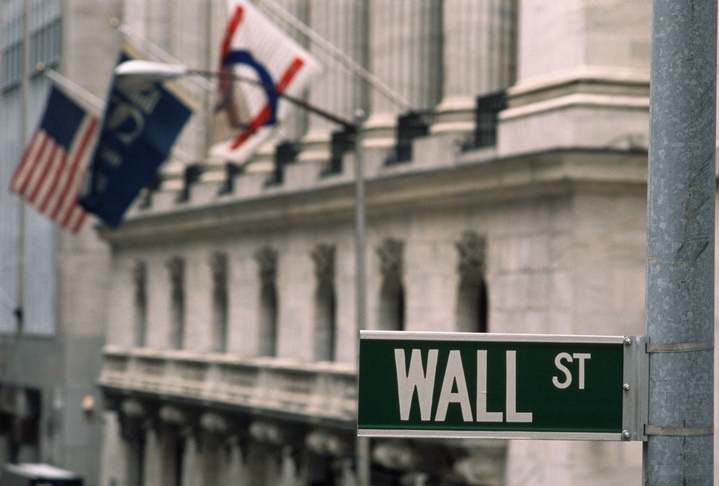
Three Simple Rules to Profit From the Next Bear Market…
And the Best High-Growth Stocks to Buy Before It Hits
Editor’s Note: This is an unusual issue of The Big Secret on Wall Street.
Today (as we often do), we’re discussing a potential recession and bear market, why it may happen, and how to prepare. What follows is hard-earned, actionable insight from Porter, based on his 25 years of navigating markets.
And we’ll also be talking about a short-term bullish market situation in the meantime. Yesterday’s rate cut means that the Fed is flooding markets with artificial liquidity… and higher inflation means that bonds are not the place to go… and investors are buying stocks because they will hold value better.
In short, before we get a meltdown… we may be headed for a melt-up.
To take advantage of this unprecedented market situation, we’re moving a select group of high-growth stocks on our “Watchlist” into the “Buy” category. Paid-up Big Secret readers will see those recommendations in this issue.
If you’re not a member, and you’d like to sign up, please click here – or call Lance James, our Director of Customer Care, at 888-610-8895 or internationally at +1 443-815-4447.
I’m right a lot.
That’s not bragging. It’s just a sober statement of fact.
If you’ve been with me for any portion of the past quarter-century (and some of you have been there for all of it)… you’ll remember that I’ve consistently called major drops in the economy and collapses of major companies, well ahead of time.
My team and I predicted the dot-com crash. We warned of the demise of General Electric (GE), of General Motors (GM), and of Fannie Mae (FNMA) and Freddie Mac (FMCC). We predicted the Great Financial Crisis. Along the way, we made our subscribers a series of five-digit gains that paid subscribers can peruse in our Hall of Fame.
If you were with me as recently as last year, you remember airplane manufacturer Boeing (BA)…
In January 2023, Porter & Co. warned investors to avoid America’s greatest (and most strategically important) mega-cap stock. We said it would soon “collapse.” And – almost exactly one year later – a door blew off a brand-new Boeing 737 mid-flight, the Federal Aviation Administration grounded a big chunk of Boeing’s fleet – and Boeing stock fell 9% in two trading days.
Since then, it’s shed another 40%, and things have only gotten worse for the troubled company – with mounting legal troubles, thousands of Boeing workers now striking, and Moody’s threatening to downgrade Boeing’s credit rating to junk.
There’s no magic to making these prescient calls – just years of experience, deep insight, and good pattern recognition. When I started Stansberry Research from my kitchen table, I had a crappy laptop and access to the same publicly available Security and Exchange Commission (“SEC”) documents and financial filings that anyone with an internet connection does. What gave us our edge was a dogged commitment to the truth – and a willingness to piss people off when they didn’t like what we found.
My point is that I have a long history of successfully predicting disasters – and showing my readers how to stay out of trouble.
But I have to admit… Right now, I’m as uncertain about what comes next for the economy and the stock market as I ever have been in my career. Let me explain…
Another Crisis Is Unavoidable (Sooner or Later)
The economic warning signs have been popping up for the past couple years…
But in just the last few months, we’ve seen mounting evidence that the economy is barreling toward a severe recession.
For example, Treasury yield-curve inversions – when the yield on short-duration U.S. Treasury debt trades above the yield on long-duration Treasuries – have correctly predicted every recession since World War II. However, it is only after the yield curve “uninverts” that those recessions have materialized.
That’s exactly what happened this month, when the 2-Year U.S. Treasury yield moved back below the 10-Year Treasury yield, following one of its longest (two-plus years) and deepest inversions in history.
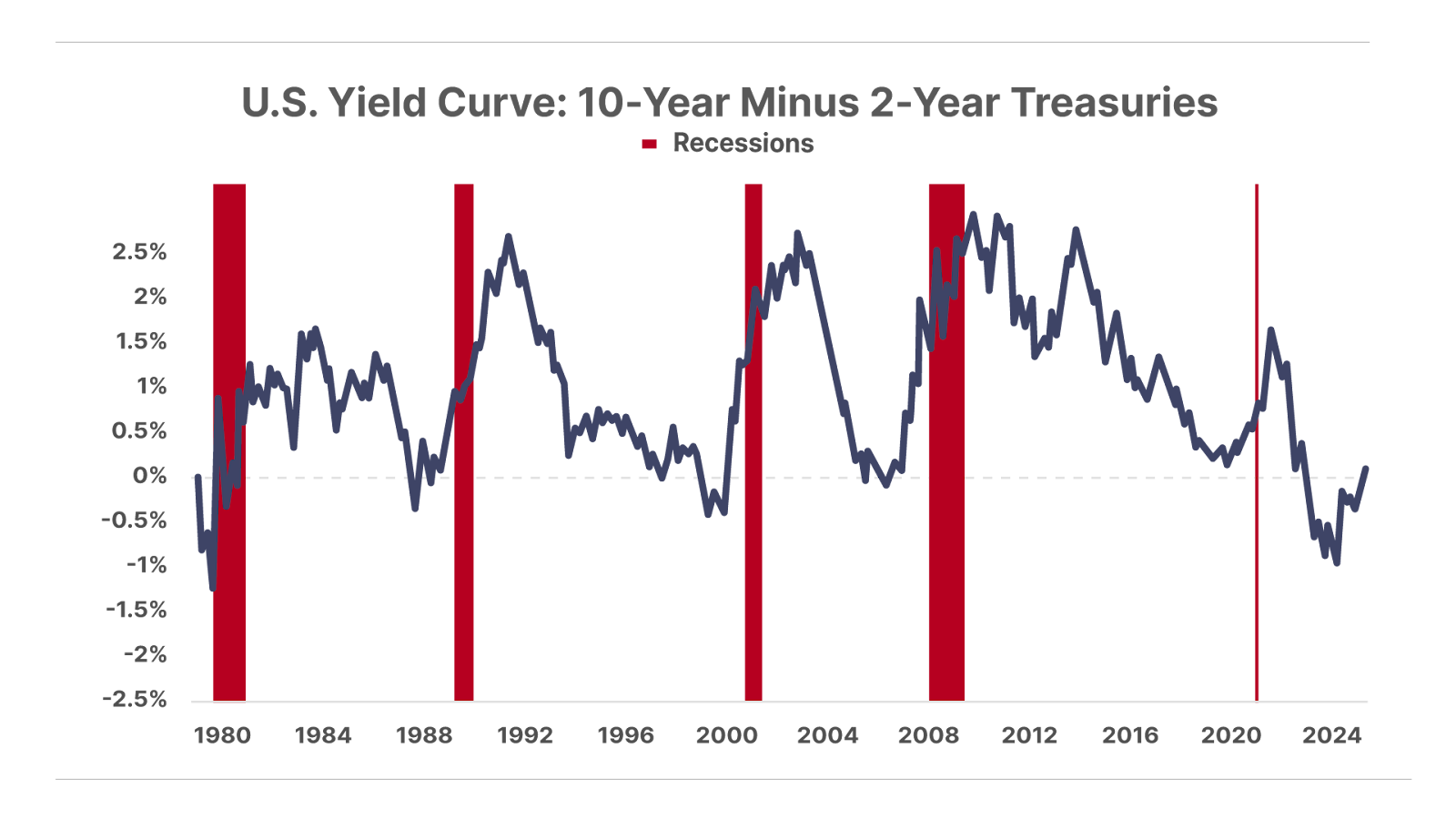
In addition, the U.S. consumer is now showing signs of significant distress. We first noted signs of consumer weakness in the quarterly reports of bellwether brands like McDonald’s (MCD) and Starbucks (SBUX) early this year. Since then, weakness has begun to materialize in a growing list of companies, including such historically “recession-proof” businesses as PepsiCo (PEP) and Procter & Gamble (PG).
Consumer credit card charge-offs at U.S. banks have quietly risen to their highest level in 13 years, as persistent inflation (rising prices) has collided with dwindling COVID-era stimulus savings (which means less spending money). And with Americans now owing a record $1.14 trillion in credit card debt – and paying a staggering average 22.8% interest on that debt – these problems are likely to get much worse.
But the most worrisome recessionary “red flag” has now shown up in the labor market…
Full-time employment fell by a massive 1 million workers in August, marking the seventh consecutive monthly decline. And this followed the unemployment rate jumping to a post-COVID high of 4.3% in July. This increase triggered another reliable recession indicator known as the Sahm Rule.
Created by economist Claudia Sahm, the rule states that if the three-month average of the unemployment rate rises by a half-percentage point or more over the lowest three-month average over the previous year, the economy is in recession. And last month’s rise in unemployment officially met that condition.
This combination of the job market cooling off (and unemployment rising) has historically been the key signal that a recession is imminent. In fact, according to the Sahm Rule, it could already be underway.
Meanwhile, the major stock market indexes are trading near record-high valuations by nearly every important metric.
A recent Bank of America analysis shows that the S&P 500 is trading well above its long-term historical averages in 19 out of 20 key valuation metrics. Total market capitalization divided by GDP (Warren Buffett’s favorite measure of value) is higher than at any point since data has been kept, starting in 1964… and the Shiller P/E, a longer-term price-to-earnings multiple that “smooths” valuation fluctuations over a 10-year period, is double its long-term average.
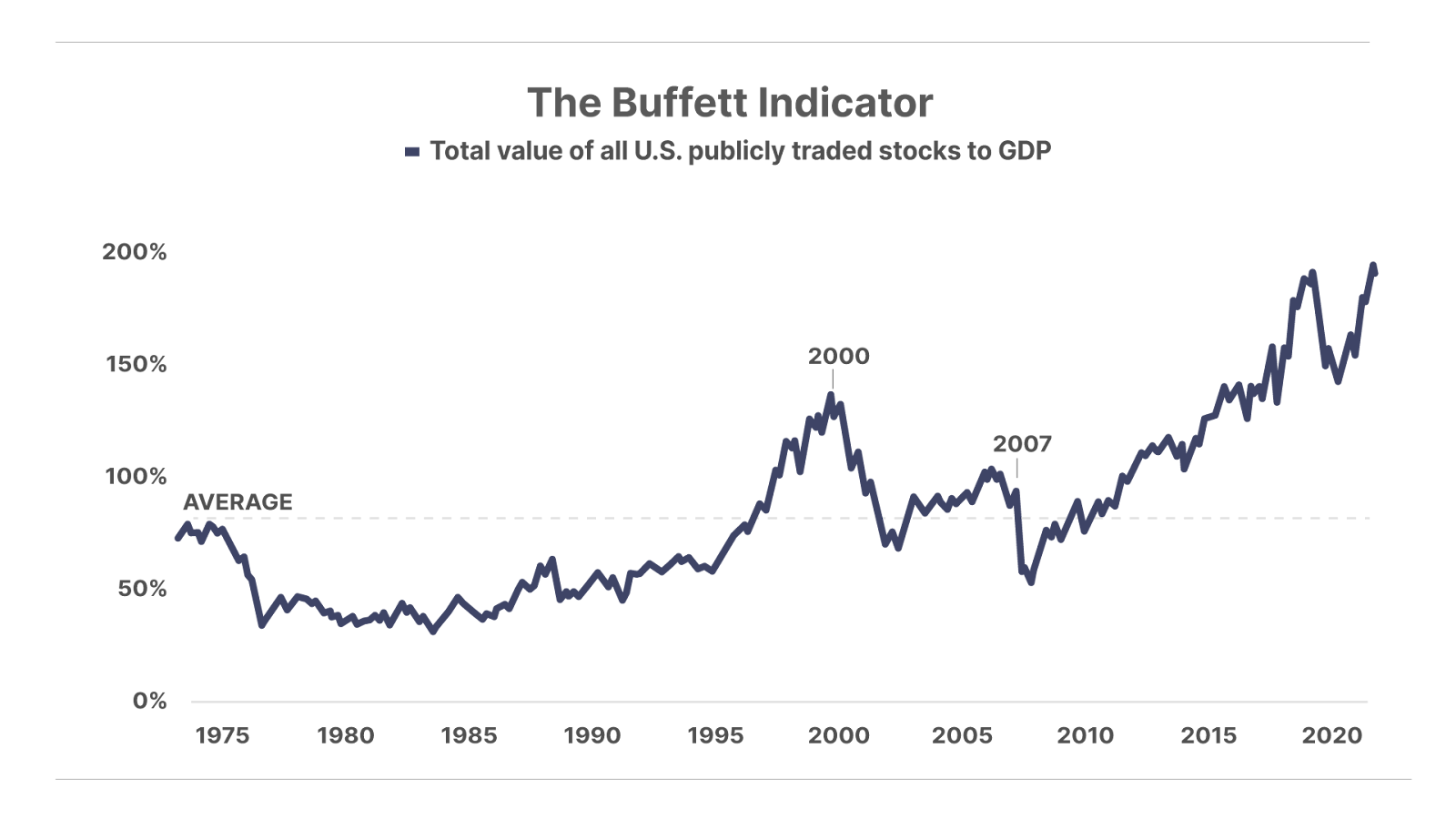
In any ordinary scenario, this combination of risks would suggest a severe recession and stock-market meltdown could begin at any time.
But this is no ordinary scenario…
Melt-Up Before Meltdown?
You see, all of this is occurring as government deficits are soaring like never before. Just this month, the U.S. Treasury reported a massive increase in overspending, revealing a $380 billion deficit for the month of August, versus economist expectations of a $293 billion surplus.
That’s a miss of almost $700 billion… and it brings the total U.S. budget deficit to $1.9 trillion for the first 11 months of the 2024 fiscal year (which ends in September for the U.S. government), up 24% from the same period last year.
This year’s budget deficit represents nearly 6% of U.S. gross domestic product (“GDP”) – a level that’s unprecedented in U.S. history, outside of wartime or a severe economic downturn.

In other words, the U.S. government is spending as if we’re already in a crisis… before any crisis has even begun.
Worse, the government’s vast (and growing) unfunded entitlement obligations make even modest cuts to this runaway spending politically impossible. With two-thirds of U.S. federal spending now going toward “mandatory” transfer payments (equal to 15% of GDP), and annual interest payments on existing federal debt recently surpassing $1 trillion for the first time, these historic deficits are not ending anytime soon.
At the same, the Federal Reserve is now aggressively cutting interest rates for the first time since the COVID-19 lockdowns. Just this week, the Jerome Powell-led Fed voted to cut interest rates by 50 basis points… despite official measures of inflation that remain well above the central bank’s official 2% target.
Importantly, this potent (and unprecedented) cocktail of fiscal and monetary stimulus has the potential to overwhelm the growing recessionary forces, at least for a time.
In short, I’m no longer sure if we’ll imminently experience a recession and stock market meltdown… or, if we’ll first experience an inflationary boom and stock market melt-up, that is later followed by a severe downturn.
As such, I believe investors should do their best to be prepared for either outcome. That means continuing to own high-quality stocks and other assets that will benefit from a potential melt-up, while also beginning to prepare for the inevitable meltdown that will eventually arrive.
And today, I’m going to help you do just that…
During the Great Financial Crisis of 2008-2009, I helped my readers successfully navigate the worst bear market since the Great Depression of the 1930s. And below, I’ll share a handful of bear market “rules” that will help you survive – indeed thrive – in the next one, as well.
Bear Market Rule #1: You Must Hold Cash
In early 2008 – roughly two months before the supposedly “contained” (the infamous term used by Fed Chair Ben Bernanke at the time) problems in the mortgage market erupted on Wall Street via the failure of investment bank Bear Stearns – I warned readers it was time to be “extremely cautious” and urged them to hold some extra cash. As I wrote in the January 2008 issue of Stansberry’s Investment Advisory…
The impact of falling real estate prices is being magnified by the leverage of the system. And, even worse, the damage to the banking system means it will be much more difficult for the Federal Reserve to stimulate economic growth through additional lending.
This is a time to be extremely cautious with your own finances. I believe the S&P 500 will fall this year, by more than 10%. Most stocks will probably decline this year. Thus, simply holding cash isn’t a bad strategy right now – your cash will probably outperform your stocks in 2008.
Of course, I don’t have a crystal ball. At that time, I had no way to know that the crisis was imminent… or how severe it would be.
What I did know was that the likelihood of a significant stock market decline was rising… and I wanted my readers to be in a position to take advantage of the opportunities that were likely to develop because of it.
That’s because taking advantage of bear market bargains requires more than just the knowledge to buy when most investors are selling – to “be greedy when others are fearful,” as legendary investor Warren Buffett has famously said…
You must also have the cash available to do so.
This should be fairly obvious. Unfortunately, most investors tend to remain fully invested until a crisis is already underway… and only begin to raise meaningful amounts of cash after stocks have entered a bear market. By then it’s too late.
This behavior is doubly harmful… It locks in big losses on the stocks you sell. And it leaves you with relatively little cash available to take advantage of bear market opportunities.
The key to avoiding this fate is to have cash available before trouble begins… when – like today – warning signs are mounting but most investors remain blissfully unaware. Despite my belief that an inflationary stock market melt-up is possible, I continue to recommend investors hold as much as 25% of their portfolios in cash today.
(You can learn more about how to raise and hold cash in an issue of The Big Secret from last year, right here.)
Bear Market Rule #2: “Hedge” Your Cash With Hard Assets
I also recommend holding a small percentage of your cash in hard assets that do well during periods of monetary inflation.
The reason is simple… As I mentioned above, the Fed and Treasury are already “goosing” the economy today. And the government’s response to every severe recession or bear market since the 1990s has been to flood the financial system with even more monetary and fiscal stimulus that causes the value of the U.S. dollar to decline. I reminded readers of this in the December 2008 issue of Stansberry’s Investment Advisory…
Folks worried about a lasting deflation (as opposed to a temporary liquidity crisis) simply don’t understand there are no limits to the amount of money and credit the Federal Reserve can create at will. For example, the Fed has the power to make loans directly to General Motors or simply buy equities or corporate bonds on the open market. No other central bank in the world wields this amount of power. The Fed is the ultimate source of the world’s money and credit because the dollar is the world’s reserve currency.
At that time, my favorite monetary inflation hedge was gold bullion – plain, regular gold coins. Gold was – and still is – the only asset that has maintained its value for thousands of years. So I still recommend every investor own some gold today.
But now I also recommend holding Bitcoin as well. This cryptocurrency wasn’t around in 2007 leading into the the Great Financial Crisis (it was allegedly created as a response to the bailouts following that crisis), but shares several of the same monetary qualities – including scarcity, durability, and fungibility – earning it the nickname of “digital gold.”
In fact, by some measures, Bitcoin is arguably an even better store of value than gold. It’s also much more than just a store of value… This decentralized, digital monetary network allows seamless monetary transfers to anyone around the globe with the click of a button. It’s a peer-to-peer transfer mechanism, which means it exists outside the scope of governments and central banks, making it the most legitimate international, reserve currency.
That said, Bitcoin has only existed for around 15 years… It simply can’t compare to gold’s centuries-long track record of reliably storing value through crises. For that reason, we recommend owning a little of both.
Bear Market Rule #3: Be Prepared to Follow Buffett’s Advice
Raising cash prior to a crisis is only part of the equation. You must also have the emotional discipline to follow Warren Buffett’s advice above, and put that cash to work. I explained why this is so important in the April 2008 issue of Stansberry’s Investment Advisory…
If I can convince just one subscriber to ignore his emotions, forget his fears, and buy high-quality stocks when they’re cheap – and ignore everything else – I will have accomplished something important with this letter.
With the S&P 500 down 24% from its peak to its recent trough, we are in the midst of a real bear market. My belief today is stock prices – on average – are going to go lower. Perhaps even much, much lower… I don’t think we’ve seen the “throw in the towel” moment…
While most of your financial advisors will undoubtedly tell you to trim your exposure to stocks and “batten down the hatches” financially – you will get the opposite advice from me.
Do you think Warren Buffett, Sam Zell, Marty Whitman, Bill Gross, Jim Rogers, Jeremy Grantham, Steve Leuthold, Mark Mobius, or any other extraordinarily successful long-term investor trims his portfolio during bear markets? Absolutely not. That’s when they put their cash reserves to work.
Great investments are made during bear markets. Great investors earn their reputations during bear markets. The fortune you hope to gain from the markets will be made by what you do during bear markets. It’s easy to buy and hold during good times. It is much, much more difficult to put money to work in critical situations when you have to go against the crowd and your own fears.
While most investors understand this strategy in their heads, few investors have the fortitude in their hearts to act while others are panicking. Once again, the key is preparation. More from that issue…
To my knowledge, there’s only one way to do the right things during these critical times: You must know how to evaluate equity values. And you must understand the margin of safety you have in your investments. Without this knowledge, it is nearly impossible to sit on your hands and hold on. If you don’t have firm knowledge of the value of your stocks and confidence in their intrinsic value, you will eventually cave in to your fears. You’ll join the panic – at exactly the wrong moment.
But… if you know the value of what you own and if you’re confident in the ‘margin of safety’ in your investments, you should have absolutely nothing to fear.
It’s also a great idea to create a “shopping list” of high-quality stocks you’d like to own. Ideally you’ll have been following a business for years and you’ll know it inside and out – that’s why you’ll have the confidence to buy when others don’t. And, as you’ll discover if you become a life-long connoisseur of great businesses, the trick to achieving outstanding long-term results lies in only buying when the price is reasonable.
This is exactly why we created our list of Buffett-style “Inevitables” that we’ve shared periodically with Big Secret on Wall Street readers.
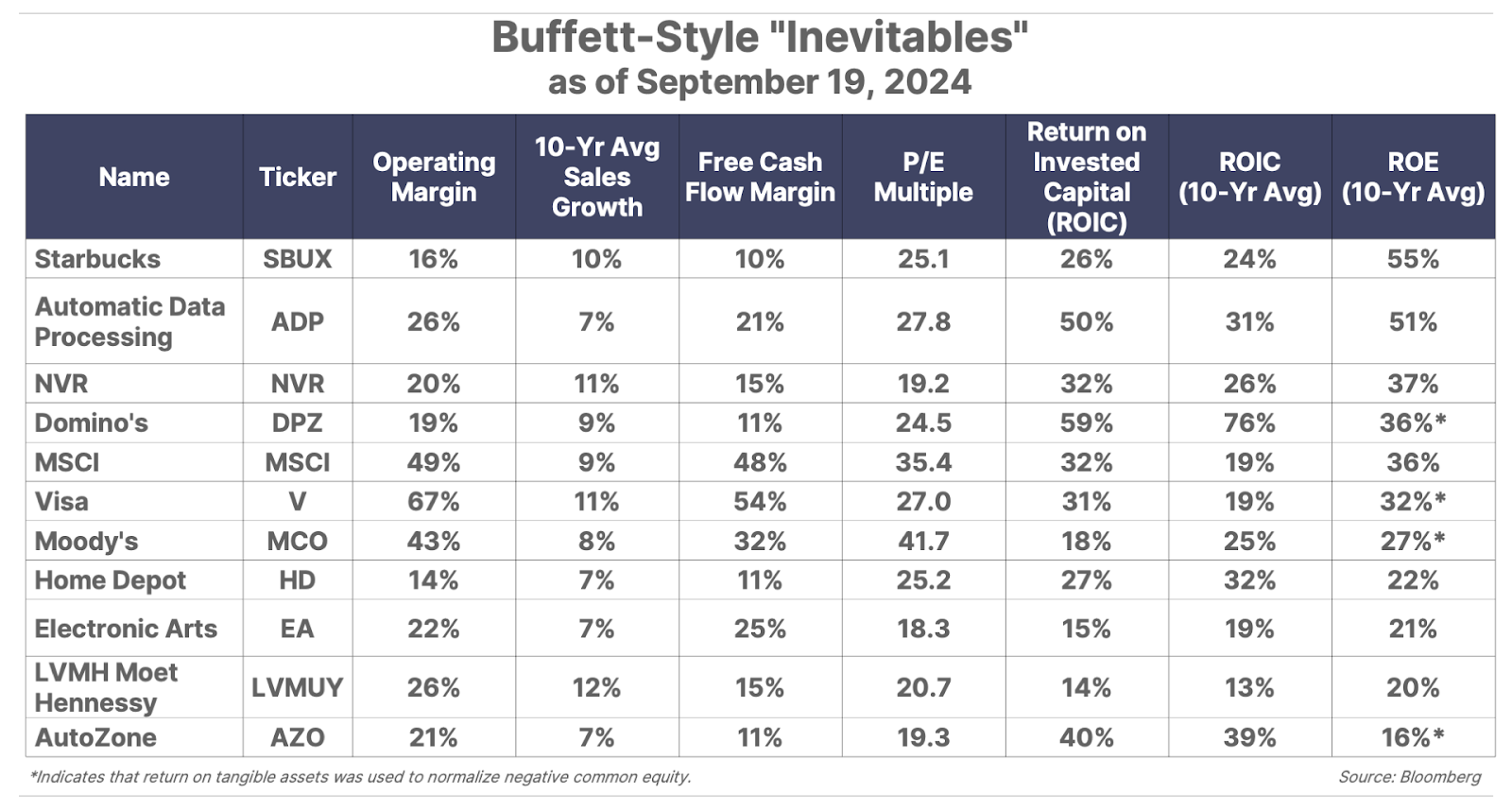
These businesses have such powerful internal economics and entrenched competitive advantages that they are likely to continue to dominate their industries – and compound investors’ wealth at high rates of return – over the long term… regardless of what is going on in the overall economy. And I repeat… the key to success is simply not to pay too much for them.
We recommend that the stocks on this list should eventually make up the core of any good portfolio. They offer what we consider the optimal balance between world-class economic characteristics, resilient business models, and reasonable growth prospects.
There are two other groups of stocks we believe investors should add to their watchlists and buy when they trade at attractive prices.
The first is what we call the “Lindy” List. This list refers to Lindy’s Law, as we’ve written about previously. In short, Lindy’s Law says that the longer something has existed, the more likely it is to continue to exist. Understanding Lindy’s Law will lead you to own businesses that have long track records and thus provide the best odds of producing substantial wealth.
Thus, Lindy businesses (as you can see in the table below) are those that age like fine wine, growing more powerful and entrenched as they grow older. For investors, that means a virtually future-proof investment, free from the threat of technological obsolescence or shifting consumer preferences.
But simply having an enduring business model isn’t enough for a high performing investment. That’s why we’ve narrowed the Lindy List down to include only businesses with excellent operating margins (double-digit minimum) and strong returns on equity (“ROE”) of at least 20%.

Virtually all of the names on this list have dominated their industries for at least the last half-century. This Lindy effect at work in these brands means that these enduring companies are much more likely than the average business to continue extending their life expectancy for decades to come. Note that these are typically slower-growing companies, as they have all reached a mature phase of market saturation. However, we believe these slow and steady businesses should offer a high degree of safety and security for more conservative investors.
Our final list is for more aggressive investors seeking higher-growth, higher-returning opportunities in the technology sector. These “Tech Inevitables” generally come with more uncertainty and higher share-price volatility, but we consider this group to be among the surest investment options in the sector. They each hold a dominant share of their respective markets, with enduring moats that have kept their competitors at bay for at least the last decade.
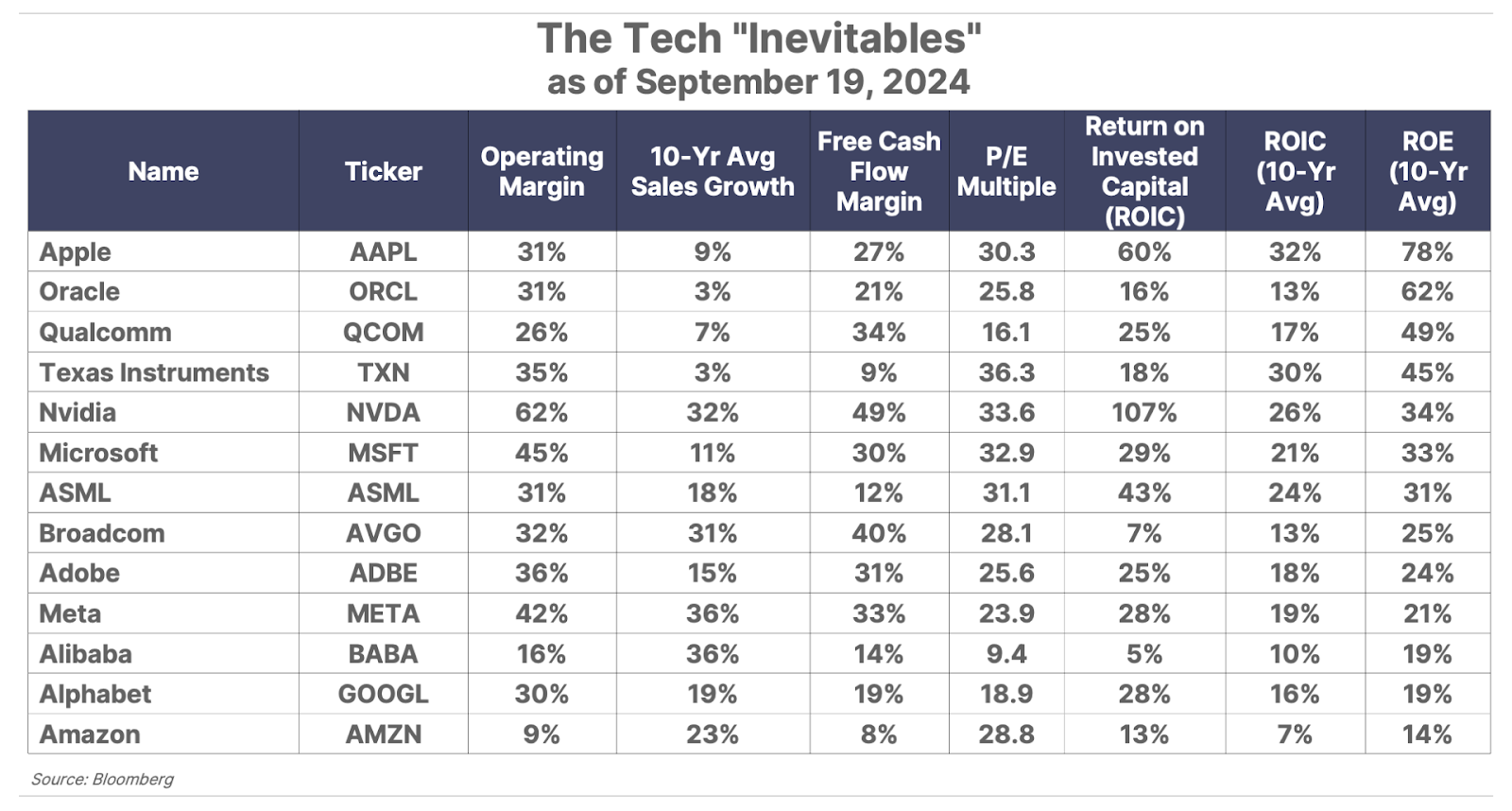
Warren Buffett has famously avoided tech stocks, outside of rare exceptions like Apple (AAPL). We believe this is a mistake. Looking at the revenue growth, margins, and returns on capital of these businesses explains why they’ve been some of the highest-returning stocks in the market for decades. And each benefits from one or another form of customer lock-in, which keeps demand for their products growing at rapid rates, regardless of the ever-shifting technological landscape.
While these high-growth stocks come with more risk than the Buffett-Style Inevitables and those on the Lindy List, they also offer significantly higher returns. Once again, the key to capturing these returns without taking on excess risk comes from only buying them at the right price.
For our paid-up subscribers, implementing this strategy is straightforward: We will tell you exactly when to buy these stocks (and others) of the world’s best businesses.
If you’re not yet a subscriber, I would encourage you to spend some time really getting to know these companies. In particular, you should know roughly what they’re worth and at what price you’d be willing to buy them. Or better yet, just join us and let us do the heavy lifting for you!
This content is only available for paid members.
If you are interested in joining Porter & Co. either click the button below now or call our Customer Care team at 888-610-8895.